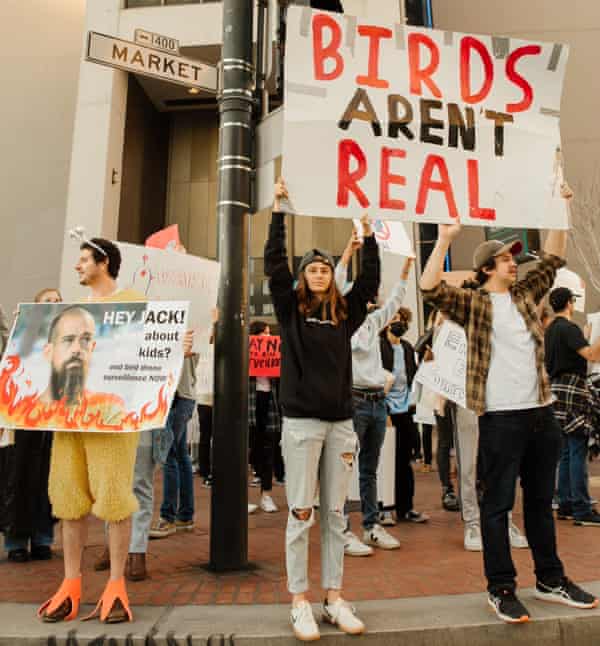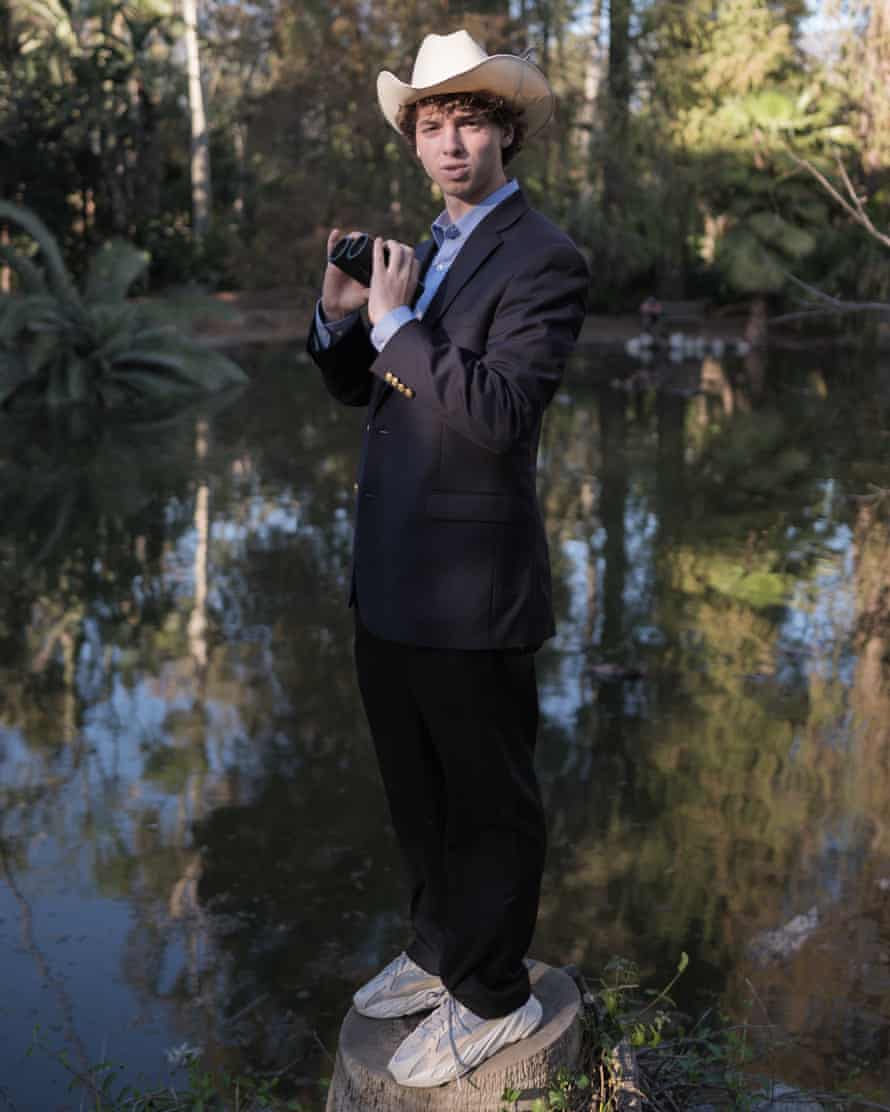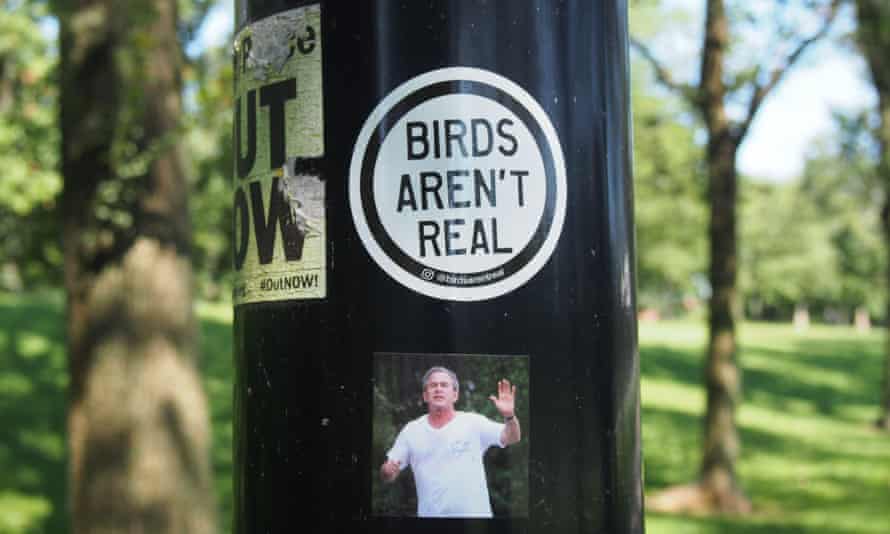‘The lunacy is getting more intense’: how Birds Aren’t Real took on the conspiracy theorists
In early 2017, Peter McIndoe, now 23, was studying psychology at the University of Arkansas, and visiting friends in Memphis, Tennessee. He tells me this over Zoom from the US west coast, and has the most arresting face – wide-eyed, curious and intense, like the lead singer of an indie band, or a young monk. “This was right after the Donald Trump election, and things were really tense. I remember people walking around saying they felt as if they were in a movie. Things felt so unstable.”
It was the weekend of simultaneous Women’s Marches across the US (indeed, the world), and McIndoe looked out of the window and noticed “counterprotesters, who were older, bigger white men. They were clear aggravators. They were encroaching on something that was not their event, they had no business being there.” Added to that, “it felt like chaos, because the world felt like chaos”.
McIndoe made a placard, and went out to join the march. “It’s not like I sat down and thought I’m going to make a satire. I just thought: ‘I should write a sign that has nothing to do with what is going on.’ An absurdist statement to bring to the equation.”
That statement was “birds aren’t real”. As he stood with the counterprotesters, and they asked what his sign meant, he improvised. He said he was part of a movement that had been around for 50 years, and was originally started to save American birds, but had failed. The “deep state” had destroyed them all, and replaced them with surveillance drones. Every bird you see is actually a tiny feathered robot watching you.

Someone was filming him and put it on Facebook; it went viral, and Memphis is still the centre of the Birds Aren’t Real movement. Or is it a movement? You could call it a situationist spectacle, a piece of rolling performance art or a collective satire. MSNBC called it a “mass coping mechanism” for generation Z, and as it has hundreds of thousands of followers on social media, “mass”, at least, is on the money.
It’s the most perfect, playful distillation of where we are in relation to the media landscape we’ve built but can’t control, and which only half of us can find our way around. It’s a made-up conspiracy theory that is just realistic enough, as conspiracies go, to convince QAnon supporters that birds aren’t real, but has just enough satirical flags that generation Z recognises immediately what is going on. It’s a conspiracy-within-a-conspiracy, a little aneurysm of reality and mockery in the bloodstream of the mad pizzagate-style theories that animate the “alt-right”.
Birds Aren’t Real didn’t stay in Memphis – in a sequence reminiscent of the Winklevoss scene in The Social Network, when they realise just how big Facebook has become, McIndoe recalls being back at college, five hours away from Memphis. “I remember seeing videos of people chanting: ‘Birds aren’t real,’ at high-school football games; and seeing graffiti of birds aren’t real. At first, I thought: ‘This is crazy,’ but then I wondered: ‘What is making this resonate with people?’”
It’s no surprise that it first gained popularity among high schoolers. The younger you are, the quicker you get it. “Teenagers understand it, they don’t need footnotes,” McIndoe says. I asked my own two teenagers if they were aware of Birds Aren’t Real. They went off on some crazy extemporising, where pigeon was pronounced “piggin” and doves had the greatest surveillance accuracy, and it seemed that they really did have a good working knowledge of how a fake conspiracy theory functioned, with its need for jargon and taxonomy. Then I asked again the next day, and it turned out that they’d never heard of it, they were just taking the piss. Teenagers do just seem to get it. I still need quite a lot of footnotes.

This is the fourth interview McIndoe has given as himself, not his conspiracist character. If you go looking for interviews with him on Spotify, you will find him explaining to sub-Rush Limbaugh local radio shock-jocks, in total seriousness, how the CIA was explicitly founded to spy on the American public – these robot birds were their crowning achievement, listening to and watching everyone all the time.
He describes sombrely but matter-of-factly the genocide of the real birds, which Birds Aren’t Real was tragically unable to prevent. The shock-jock will typically say something noncommittal, such as: “Huh. That’s bad.” (In fairness, if it were true, it would be quite bad.)
It’s a vivid dramatisation of how divisive conspiracy theories are; people who believe them live in another world, where any wild theory flies and even the most fleeting attempt to fact check it or test it against logic (if birds have been destroyed, who’s eating all the worms?) marks you out as a brainwashed liberal. People who don’t believe them cannot think themselves into the headspace of those who do. Then along comes a guy with a sign, and maybe he’s not bridging this implacable divide, but he’s certainly disrupting it.
That day of the Women’s March, as McIndoe ad-libbed his conspiracy to whoever would listen, he had no plan. He was talking about robot birds one minute and “Killary Clinton” (a trope used by conspiracists about Hillary Clinton) the next: “I was just saying things that were the funniest thing to me at the time.”
“It was a character based on the people I grew up around,” he says. “I grew up in rural, deeply conservative Arkansas, in a home-school environment. I had these intensely negative experiences of it. I’m not a conservative person. At a very young age, I became more of an observer than a participant, which created a real loneliness, from an ideological standpoint.”

Until he could drive, McIndoe’s entire life was home, home-school co-operatives run by the church, and church. He knew no one who didn’t believe exactly the same thing, and “Even though everything is [an] echo chamber,” he says, “the ideas in these home-schooled communities are bad echoes. I’m sure that there are beautiful Christian communities that are doing good things somewhere. I’m not trying to bash spirituality. But from my experience, the deep fundamentalist communities that I was in have caused way more harm. And I’ve seen pure evil coming from them.”
As his movement grows, though, he’s started to think that maybe that kind of schooling made him more independent-minded, even though it emphatically didn’t intend to. “It creates a different relationship with the world. I wasn’t involved in normal cultural settings, I was barred from a lot of traditional media. I didn’t go to school. It definitely creates a different type of thinking, which can be in some ways more free and exploratory.”
He also draws a tentative line between faith and conspiracy theory: “The Christian worldview is really just about how you’re determining truth. Where are you getting truth from? What is your relationship with truth? For the Christian, your foundational relationship with the truth is determined by faith, its definition is that you can’t argue with it or interrogate it.”
That mindset, plus the religious yearning for one single theory that explains everything, really softens up the brain – these are my words, not his – for conspiracy theories, which meet the same need. I think there is an actual concrete example of this journey, from fundamentalist Christianity to QAnon (again, this is definitely me not him, he is much less strident than I am). The paedophile element of QAnon, where Hillary Clinton and a huge global web of powerful liberals, are abusing children and keeping them in tunnels, sounds completely unhinged. But if you’ve been vehemently anti-abortion on faith grounds for years, then to your mind, feminists and other liberals are already in favour of murdering children.
So the leap isn’t as great as it looks. McIndoe is more interested in “tribal language” and how “conspiracy theory language echoes, in many ways, what I saw in a religious community. From QAnon, one of the main tag lines was ‘the storm is coming’. I hear many Christians talking about that right now, about coronavirus and the end times.”
One more thing happened on the first day of Birds Aren’t Real. “I met someone, her name is Madeleine. She has been my girlfriend for four years, she’s the love of my life.” So before long, he decided to drop out of college, and move to Memphis. “I lived with people I didn’t know, and worked at the richest country club in the south, as a waiter. It gave me a real window into how the 1% of Memphis talks about other races, since the entire staff are minorities. It was a very interesting time to start an idea about American polarisation.”
Although “birds aren’t real” was very quickly picked up as a chant, getting the movement to snowball “did take some work”, McIndoe says. “We set up the Bird Brigade, our boots-on-the-ground activism network, led by Claire Chronis. That was the first step to building a structured movement, getting it from Memphis to the rest of the US, getting people to put up flyers that I designed very poorly on Photoshop, which works for the conspiracy theory aesthetic.”
They made up facts, faked secretly leaked CIA documents and made videos – “we created a world with laws and evidence” – and took out billboard adverts, which people posted on Instagram as selfie backdrops. “If you put something absurd into the world, people are trying to present themselves as irreverent or funny, so that really spread.”
Meanwhile, “real conspiracy theorists,” he says, “will approach me like I’m their brother, like I’m part of their team. They will start spouting hateful rhetoric and racist ideas, because they feel as if I’m safe.”
In describing the movement, he gets towards perhaps the closest definition of what is happening: “It is a collective role-playing experiment. There is true community found through this, it breaks down political barriers. We have taken pictures of a car park at a Birds Aren’t Real rally. There are people who will show up with a US flag on their car, Republican, patriotic, and a car right next to them with Bernie Sanders stickers. I was a Bernie guy myself. You see these people marching together, unified.”
They’re unified on the prank, right? There aren’t people there who think birds genuinely aren’t real? (I still need a lot of footnotes.) “Yeah, they’re role-playing together. They’re role-playing the collective understanding of the conspiracy theory.”
The response of real-life conspiracists to Birds Aren’t Real has shifted now: “They think Birds Aren’t Real is a CIA psy-op. They think that we are the CIA, we’re put out there as a weapon against conspiracy theorists.”
McIndoe has a long game with Birds Aren’t Real: “I think it has the potential to be a creative collective for a long time. I would love Birds Aren’t Real to continue to be a space to process the badness. I don’t think the madness is going to necessarily end. I think the lunacy is going to become more intense.”
He ends with an image that is poetic, freighted and incredibly neat. “We talk about it like an igloo. Making a shelter out of the same thing that’s posing the threat. Take the materials of what is around us, build something with them, be safe in there together, and laugh.”


